18 August 2025
0 0
Ethereum Transitions from Utility Token to Recognized Digital Reserve Asset
Ethereum has transitioned from a utility asset to a recognized store of value, attracting institutional interest.
Integration into Traditional Finance
- Since its launch in 2015, Ethereum has evolved through ICOs, DAOs, and retail adoption.
- By 2020, ETH became a core collateral layer in DeFi, attracting funds from family offices and crypto VCs.
- In 2022, macro funds and corporates began investing, leading to the establishment of ETFs.
- Pension funds and global allocators are now engaging with ETH as a legitimate asset class.
- Historically, once institutions adopt an asset, central banks follow suit.
Emergence of Tokenized Assets
- Ethereum is becoming essential for the next financial era, enabling trillions in transactions.
- ETH has transformed into a yield-bearing reserve asset for institutions.
- Transaction costs have decreased significantly, enhancing global efficiency.
- Tokenization is expanding across stablecoins, real-world assets, NFTs, and corporate treasuries.
- Decentralization positions ETH as a global neutral settlement layer.
- Institutions view ETH as productive collateral, reinforcing its role in the future of finance.
